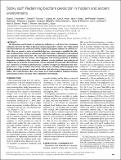Sticky stuff : redefining bedform prediction in modern and ancient environments
Abstract
The dimensions and dynamics of subaqueous bedforms are well known for cohesionless sediments. However, the effect of physical cohesion imparted by cohesive clay within mixed sand-mud substrates has not been examined, despite its recognized influence on sediment stability. Here we present a series of controlled laboratory experiments to establish the influence of substrate clay content on subaqueous bedform dynamics within mixtures of sand and clay exposed to unidirectional flow. The results show that bedform dimensions and steepness decrease linearly with clay content, and comparison with existing predictors of bedform dimensions, established within cohesionless sediments, reveals significant over-prediction of bedform size for all but the lowermost clay contents examined. The profound effect substrate clay content has on bedform dimensions has a number of important implications for interpretation in a range of modern and ancient environments, including reduced roughness and bedform heights in estuarine systems and the often cited lack of large dune cross-sets in turbidites. The results therefore offer a step change in our understanding of bedform formation and dynamics in these, and many other, sedimentary environments.
Citation
Schindler , R J , Parsons , D R , Ye , L , Hope , J A , Baas , J H , Peakall , J , Manning , A J , Aspden , R J , Malarkey , J , Simmons , S , Paterson , D M , Lichtman , I D , Davies , A G , Thorne , P D & Bass , S J 2015 , ' Sticky stuff : redefining bedform prediction in modern and ancient environments ' , Geology , vol. 43 , no. 5 , pp. 399-402 . https://doi.org/10.1130/G36262.1
Publication
Geology
Status
Peer reviewed
ISSN
0091-7613Type
Journal article
Description
This work was funded by the UK Natural Environment Research Council (NERC) under the COHBED project (NE/1027223/1). Paterson was funded by the Marine Alliance for Science and Technology for Scotland (MASTS).Collections
Items in the St Andrews Research Repository are protected by copyright, with all rights reserved, unless otherwise indicated.

